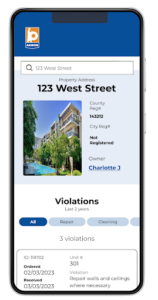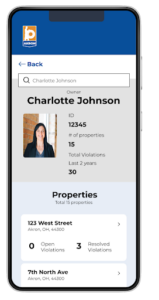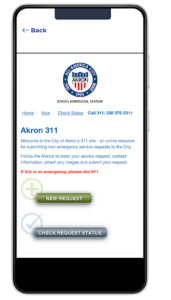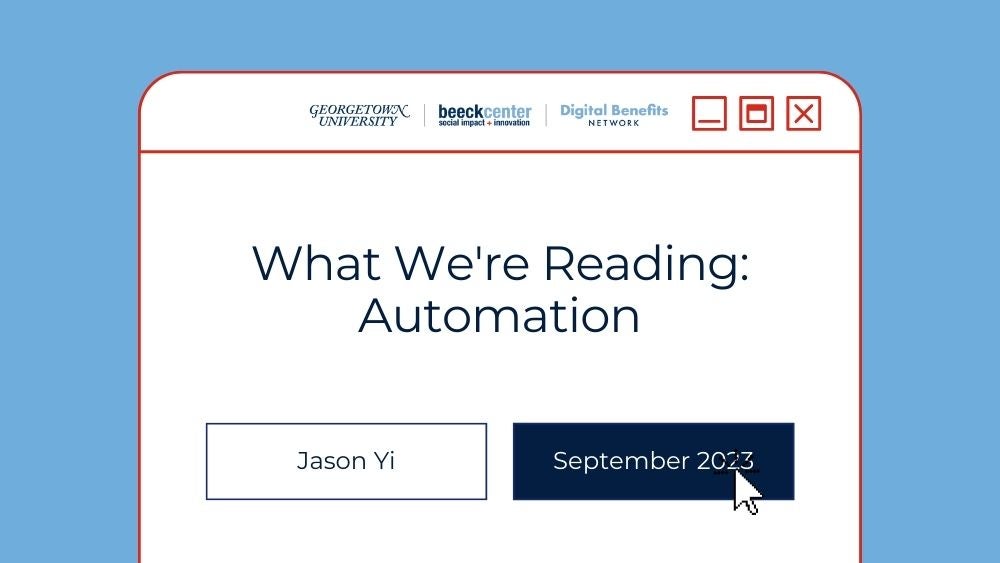Promising Practices in State Unemployment Insurance Digital Service Delivery
In response to the COVID-19 pandemic, the American Rescue Plan Act (ARPA) provided funding to modernize unemployment insurance (UI) by appropriating $2 billion to the Department of Labor (DOL); however, $1 billion was later rescinded under the Fiscal Responsibility Act of 2023. The DOL inaugurated the Office of Unemployment Insurance Modernization (OUIM) to guide and manage ARPA investments against three main goals: expand equitable access, improve timeliness, and strengthen program integrity. OUIM has supported states in their modernization journeys through grants, technical assistance, services, products, and resources.
States have shown resilience in facing ongoing challenges and have found creative ways to apply the ARPA grants, such as developing layered modular systems, ensuring adaptive technology, improving data security, and balancing accessibility and fraud prevention. However, due to the cyclical nature of UI funding and the uncertainty of future administrative funding streams, states must exercise caution with budgetary allocations and investment decisions. It will be important for Congress, DOL, and states to continue to invest in improving UI systems to meet the needs of residents ahead of future economic downturns.
Throughout Spring 2023, the Beeck Center’s Digital Benefits Network (DBN) interviewed state leaders from Illinois, New Jersey, Michigan, and Oregon, as well as representatives from the National Association of State Workforce Agencies (NASWA), about their experiences delivering UI—ranging from customer experience, language access, digital delivery, and data and analytics. The DBN’s outreach has shed light on promising practices emerging from states’ efforts to modernize UI systems—approaches that have potential to improve efficiency, security, and lead to more equitable outcomes. We detail these below to inspire practices for other states to replicate.
Language Access
Developing multiple language frameworks simultaneously
Several of the states we consulted prioritized improving the clarity, inclusiveness, and effectiveness of external communications. When claimants understand and navigate UI systems with ease, they are more likely to complete the process and receive the benefits they need. The Oregon Employment Department, in efforts to expand language access, developed different language frameworks simultaneously, rather than translating directly from an English source. This parallel development strategy seeks to optimize equity by tailoring user interfaces to the needs of specific non-English-language communities. To this end, Oregon has offered their UI application in Spanish and created multilingual educational videos. Oregon emphasized that partnering with native non-English-speaking communities and organizations has enabled this process.
Partnering to meet community need
The states we interviewed recognize the importance of accurate and understandable translations in increasing the accessibility of UI, and have attempted various strategies that prioritize different components of the service delivery process. The New Jersey Department of Labor & Workforce Development is developing a plain language, mobile-friendly application, which they have released using a phased approach — releasing first to 25 users in October 2023, then scaling up to 10% of users in November 2023, 50% by December 2023, and 100% of users by January 2024. They used each of these phases to identify where claimants were getting stuck or answering questions incorrectly in a way that required agent intervention, and made those improvements before the next phase of release. In collaboration with United States Digital Response (USDR), New Jersey piloted a new methodology that utilized subject matter experts on their team and in their community to ensure effective Spanish translation for the new intake application. They began by translating sections of their initial intake application into Spanish and soliciting feedback from front-line call center staff who speak to claimants about their challenges daily in Spanish. They then connected with community partners who work with Spanish speaking communities to review and share additional ideas for improvement, sometimes resulting in the phrase being presented in multiple ways and/or with the English phrase in parenthesis.
Customer Experience
Developing aids to support claimants
Michigan’s Unemployment Insurance Agency (UIA) is working to translate correspondence to jobless workers and develop online resources, such as informational videos, to address the needs of those who do not speak English as their primary language or have visual disabilities. In August 2023, UIA released a new UIA Claimant Roadmap, which consolidates and clarifies filing information into step-by-step guidance. UIA partnered with nonprofit design studio Civilla to iteratively design the guide and seek feedback from the public and agency staff. UIA has started hosting virtual, no-cost “First-time Filer Coaching Sessions” where claimants can receive guidance from trained UIA instructors on how to apply for benefits and understand what they need to do to maintain those benefits.
Improving email communication
New Jersey has updated over 50 emails with clear, trustworthy language that encourages claimants to act with urgency without threatening them or emphasizing negative consequences. By using an action-forward approach, New Jersey has been able to reduce the time for claimants to submit information by 35%. As part of these efforts, New Jersey created a re-usable email toolkit that contains a collection of styles, components, and building blocks to replicate in other states.
Data & Analytics
Partnering to hone approach and analysis
Data collection and analysis offers the opportunity to identify pain points during the UI application and after someone receives benefits. Administrators can identify and alter segments of the process where claimants face difficulties, including technical issues that could inhibit successful filings. The Illinois Department of Employment Security leveraged the expertise and capacity of external associates and surveyed customers using a survey at the end of the application to identify pain points and learn more about their experiences. Administrators partnered with DOL and their Tiger Team to refine the survey questions and expeditiously analyze data using scripts written in the programming language Python. Illinois has also partnered with masters students at the University of Chicago Harris School of Public Policy to explore survey data and customer experience as a capstone project, providing respective recommendations. The state is working to implement an additional pop-up survey throughout the application to understand abandonment and other pain points in user experience.
Building analytics into migration
New Jersey is building analytics into their digital services as they migrate from an outdated legacy system. For example, they are creating dashboards using Google Analytics data to understand error rates and the usage of key functions like scheduling an appointment, requesting overpayment waivers, and managing accounts. Additionally, New Jersey issues claimant surveys after the initial claim completion and identity verification, prompting users to comment on challenges or questions they faced, if the user understood they needed to do weekly certification, and completing identity verification. This has created a feedback loop that helps them continue to make improvements incrementally, release them quickly to residents, and gather feedback on the next improvements to prioritize
Digital Transformation
Understanding the claimant experience
Funded by a DOL equity grant, Illinois is developing three robust data sets that capture claimant information concerning likelihood to file, payment timeliness, and likelihood to exhaust benefits. Administrators plan to use these research findings to inform front-end development, optimizing the accessibility and delivery of UI. The state is also working with private contractors to revamp their online claimant portal user interface to enable mobile access and develop new features, including text message, correspondence, and status tracking capabilities. Illinois state leaders affirmed that self-serve options and users’ ability to access their own information are paramount for equity—they are also prioritizing increasing customers’ ability to access staff, and working on plain language and translation efforts.
Building consensus
As part of their digital system evolution, Oregon has begun requiring internal communication and consensus between program experts, the UI modernization teams (both internal and external vendor teams), internal communications experts, and their Equity and Inclusion Office on all initiatives. Requiring these teams to communicate and come to consensus has been time consuming but effective in developing a unified UI strategy and changing the agency’s approach so its communications are more understandable to the diverse communities it serves
Going out to the community
Michigan has partnered with affinity groups and community centers through its Community Connect Program to understand how to best improve and offer service delivery by going on-site to communities that would be most impacted by improvements. The program also works with employers who are anticipating laying off staff. The state also established a UIA Modernization Workgroup made up of business, labor, and jobless advocates who help to guide modernization reforms while prioritizing equity, customer service, and combating fraud.
What’s Next
Since the Beeck Center conducted these interviews, the DOL has released and awarded additional UI grants to states. In July 2023, the DOL announced a strategic approach to distributing the remaining UI modernization funds in Letter No. 11-23. The letter announced additional grant opportunities for Integrity, Information Technology (IT) Modernization, and Tiger Teams. On September 22, 2023, the DOL issued $204 million in UI grants to 18 states and the U.S. Virgin Islands. These grants seek to build upon evidence-based promising practices and support strategies such as modular software development and API-first development approaches.
The DOL has also released a new report celebrating the successes and highlighting the insights from ARPA investment in UI modernization. ARPA investments have not only brought about immediate improvements in states, but have also set in motion the development of sustainable and adaptive UI systems. The collaboration between states and the DOL, guided by a comprehensive strategy, ensures that lessons learned and successes achieved are not isolated instances but catalysts for a more robust and equitable UI landscape across the United States.
Acknowledgements
Thank you to UI state leaders, including Julia Dale, Michigan Unemployment Insurance Agency; Jennifer Phillips, Illinois Department of Employment Security; Gillian Morejon Gutierrez, New Jersey Department of Labor & Workforce Development; and David Gerstenfeld, Oregon Employment Department. Thank you to NASWA leaders Brett Flachsbarth, Benjamin Peirce, and Lou Ansaldi.
Georgetown students embedded in our teams are central to how we work at the Beeck Center. We are grateful to McCourt School of Public Policy Master of Public Policy candidate Oriel Gomez for designing and conducting the interviews with state UI leaders in the Spring 2023 semester, followed by Georgetown Bachelor of Science in Computer Science and Political Economy candidate Maxim Zeidman for writing this summary of promising practices in the Fall 2023 semester. This work has been overseen by Ariel Kennan, Fellow and Research Faculty for the Digital Benefits Network.






 The government sees value in this virtual advisor, but they treat it as an assistant, not as a deputy. At this time, there is a prototype enabled with natural language processing (in Romanian) and it is being taught to interact meaningfully with citizens. While Ion is somewhat
The government sees value in this virtual advisor, but they treat it as an assistant, not as a deputy. At this time, there is a prototype enabled with natural language processing (in Romanian) and it is being taught to interact meaningfully with citizens. While Ion is somewhat 